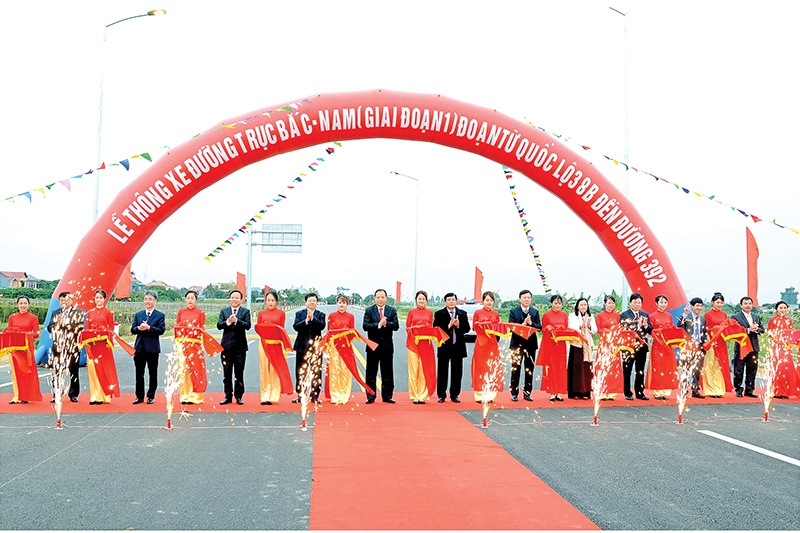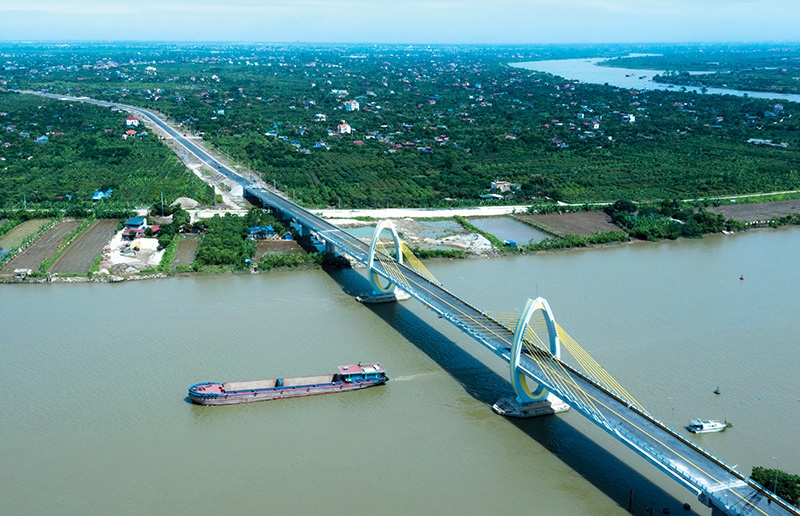Building on regional connectivity
 |
| Hai Duong has been demonstrating crucial focus on building key infrastructure links with new projects, Photo: Thanh Chung |
Hai Duong enjoys a favourable geographical position, lying in the centre of the Red River Delta and being-a part of the Hanoi, Haiphong, and Quang Ninh economic development triangle. In order to fully realise its trade potential with other regions, the provincial management has paid due regard to developing the local transport infrastructure.
Hai Duong now handles 40km passage of Hanoi-Haiphong Expressway and 82km approach roads to this highway. Additionally, the province has a 189km share of seven passing national highways and 354km share of 21 other provincial routes.
The province’s transport infrastructure system has been significantly improved and modernised in recent years, with the completion of a string of important projects. Simultaneously, the province has deployed diverse projects to enhance connectivity with nearby localities to spur regional economic development.
In the north of the province, Han Bridge approach road – the section from the District Route No.5B to the National Highway No.37 passing through Nam Sach district – was completed on time in July 2020. The 6.28km long road, with the total investment of VND218 billion ($9.47 million), helps boost the connection between national highways 5 and 37, providing a new driving force to beef up development of Nam Sach and surrounding areas. Travel time between Hai Duong city and Chi Linh city is also 20 minutes quicker.
Besides that, Hai Duong has teamed up with neighbouring localities as Quang Ninh and Haiphong to deploy several transport infrastructure projects to boost connection. Specifically, Hai Duong’s Thanh Ha district now has Quang Thanh Bridge connecting to Haiphong’s An Lao district, and Hai Duong’s Kinh Mon town has Dinh Bridge that connects to Haiphong’s Thuy Nguyen district.
The construction of Dinh and Quang Thanh bridges are major milestones for the people of surrounding areas, enabling the convenient connection between Haiphong’s southwestern and Hai Duong’s southeastern parts, promoting trade and facilitating travel between the locations.
 |
Eminent advantages
As for Quang Ninh province, the project on building Trieu Bridge, crossing the Kinh Thay River and connecting Dong Trieu and Kinh Mon towns, was completed earlier this year. To enable the connection, Hai Duong has accelerated construction and for the most part, has completed a 4.3km approach road on Hai Duong’s side of the bridge.
The completion of May and Trieu bridges aims to smoothen transport connections, pushing up development of the areas in the north of Kinh Mon town which still suffer limitations in transportation.
With the completion of these projects, Hai Duong now has eminent advantages of convenient connections with international airports, seaports, and cruise ports, as well as interregional connections.
Moving towards 2025, Hai Duong has identified one of its strategic breakthroughs as raising capital from assorted sources for the development of a modern and seamless infrastructure system, giving priority to implementing key transport projects, smart urban areas, and new-style countryside to ensure smooth connections with national highways and provincial routes.
This is not only to meet local people’s growing demand for convenient transport but also to ramp up the province’s charm, attracting outside investment into its industries and agriculture, and promoting economic structure transformation towards sustainable agriculture.
Le Quy Tiep, director of Hai Duong Department of Transport remarked that, with more than 12,000km of roads, 400km of waterways, and 60km of railway, the province will focus on development of its transport network to best fit its geographical advantages.
It will continue to review the provincial master planning from the past decade in order to identify critical routes, annulling sub-standard routes, and supplementing new ones, and thus working towards the goal of having a seamless technical infrastructure system that is interconnected between roads, rail, and local waterways, while linking the road system with industrial and economic zones.
Improving infrastructure
In order to fully realise its advantages and potential, Hai Duong has continued to improve its network of provincial roads and interregional roads, currently focusing on existing transport infrastructure works that have degraded over time and do not meet current standards and burgeoning demands for transportation, with the goal of having in pace modern works in the next few decades.
Among these developments, the focus is currently on modernising and improving the Provincial Route No.389 to reach a Grade-3 road, connecting the National Highway No.18 to the National Highway No.5 and passing through Trieu Bridge and May Bridge; modernising and improving the Provincial Route No.390 and Hop Thanh Bridge to reach a Grade-3 road connecting the National Highway No.38 to the National Highway No.37; and modernising and further improving the Provincial Route No.391 to Grade 3, connecting the National Highway No.10 from Hai Duong city to the National Highway No.5.
Other tasks include development of the north-south axis for Thanh Mien district, serving the development of industries in the province’s southern parts, connecting Bac Ninh province to the National Highway No.37; and creating a Dong Viet Bridge approach road connecting Chi Linh city to Bac Giang province’s Yen Dung district, among others.
Constantly improved transport infrastructure will enable the expansion of development space, creating opportunities for investment, maximising the economic potential of areas alongside the new connections, and overall enabling the development of industries and urban areas for the province.
The funds for these projects come from the provincial budget and local people’ contributions as well as the national budget and from the budget of neighbouring localities that share the connection.
Hai Duong Department of Transport has drafted its robust plan for the improvement of the local transport network for the 2021-2025 period, with a vision towards 2030. Accordingly, the department has suggested constructing almost 60km of new roads, improving and modernising 148km of existing provincial routes, and building 36.7km of approach roads to national highways.
The total investment cost during this period would surpass VND9.2 trillion ($400 million). In the 2026-2030 period, with the total investment value exceeding VND10.1 trillion ($439 million), Hai Duong will construct 72km of provincial routes, improving and modernising 147.6km of existing provincial routes and also building 74.6km of new approach roads to national highways.
“With our strenuous efforts and specific goals, Hai Duong’s transport system is getting closer to completion, making an important contribution to the sustainable development of the economy and the society," said Trieu The Hung, Chairman of Hai Duong People’s Committee.
What the stars mean:
★ Poor ★ ★ Promising ★★★ Good ★★★★ Very good ★★★★★ Exceptional
Related Contents
Latest News
More News
- Strengthening supply chains through trade promotions and customs reform (December 24, 2025 | 14:00)
- PM orders investment model for North–South high-speed rail (December 22, 2025 | 17:43)
- LS Eco Energy to invest in Vietnam rare earth sector (December 22, 2025 | 17:31)
- Government moves to establish International Financial Centre (December 21, 2025 | 21:00)
- Vietnam's IFC to target global investment flows (December 21, 2025 | 18:00)
- Two national hospitals expand capacity with new facilities (December 20, 2025 | 09:00)
- Ha Tinh breaks ground on major Vingroup industrial and energy projects (December 19, 2025 | 18:24)
- EVN launches major power infrastructure projects nationwide (December 19, 2025 | 18:17)
- VAL inaugurates second production line to meet domestic animal feed demand (December 19, 2025 | 16:37)
- Sun Group pioneers urban tram system in Phu Quoc (December 19, 2025 | 15:00)

 Tag:
Tag:






















 Mobile Version
Mobile Version